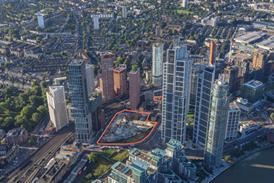- Home
- Intelligence for Architects
- Subscribe
- Jobs
- Events

2025 events calendar Explore now 
Keep up to date
Find out more
- Programmes
- CPD
- More from navigation items
Strong suburbs or regressive rhetoric?

Policy Exchange wants to give residents a vote over demolishing their own streets. Julia Park spots a few flaws in their arguments
Densifying the suburbs is not a new idea, and not a bad one. We’ve felt for a while that “the compact city”, espoused by Richard Rogers back in 1999, has worked rather too well in London and that it’s time to look at the compact suburb. But it’s not easy, politically or practically.
The risk with piecemeal intervention, as advocated in Supurbia, is that it makes everything messier. Inserting new homes at the bottom of deep gardens is usually a compromise in terms of access, servicing and outlook, and risks annoying the neighbour whose garden backs on to it. Ad hoc street infill and random “top-boxes” are equally tricky, and as soon as you start slotting in new homes, wider development becomes more difficult. That’s why I lean towards larger, planned interventions; selective demolition of the most run-down stock to release enough land to make a meaningful difference and set a precedent for others to build on. Strong Suburbs, the latest publication from Policy Exchange, therefore sounded interesting.
The authors are Ben Southwood and Samuel Hughes. Southwood has been head of policy at the Adam Smith Institute and is now head of housing, transport, and urban space at Policy Exchange. Hughes is a senior fellow at Policy Exchange and a research fellow at the University of Oxford. He was the research assistant to Sir Roger Scruton and Nicholas Boys Smith, the chairs of the Building Better, Building Beautiful Commission.
…
This content is available to registered users | Already registered?Login here
You are not currently logged in.
To continue reading this story, sign up for free guest access
Existing Subscriber? LOGIN
REGISTER for free access on selected stories and sign up for email alerts. You get:
- Up to the minute architecture news from around the UK
- Breaking, daily and weekly e-newsletters
Subscribe to Building Design and you will benefit from:

- Unlimited news
- Reviews of the latest buildings from all corners of the world
- Technical studies
- Full access to all our online archives
- PLUS you will receive a digital copy of WA100 worth over £45
Subscribe now for unlimited access.






